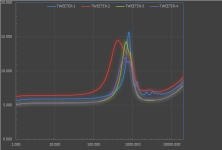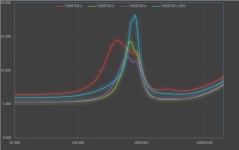A friend of mine that got into speaker construction has 4 tweeters of the same model. Using DATS v2, we measured the impedance response of these tweeters, attached. The tweeters are 6ohm nominal. The enclosures are not yet built, so for the moment we can't measure the far field response.
- Is the dispersion of the impedances ok?
- Why do three out of four of the tweeters have a double impedance peak/resonance? Is this double peaking an important clue about the tweeter quality?
- Does it matter which two tweeters we would select for a pair of speakers?
P.S. X axis is in ohm, Y axis is in Hz.
- Is the dispersion of the impedances ok?
- Why do three out of four of the tweeters have a double impedance peak/resonance? Is this double peaking an important clue about the tweeter quality?
- Does it matter which two tweeters we would select for a pair of speakers?
P.S. X axis is in ohm, Y axis is in Hz.
Attachments
Last edited:
Double impedance peaks are a well known phenomenon. Usually it's the result of a back chamber which comprises a vented pole piece in order to increase the volume and to lower the resonance frequency. Applying some damping material into the hole smoothes the impedance curve, but the remaining asymmetry still reveals the geometric construction. I wouldn't worry too much about that since the disturbance is not in the operating range of the tweeter. The small impedance peaks further up of the blue curve are more alarming IMO.
Thanks all for the suggestions. These are not new tweeters, in fact they are 20 years or more old TSX26 salvaged from equally old B&W 801/802 Matrix Series 80.
We've been able to open the tweeters (only four screws, these tweeters don't have ferrofluid to dry out) and clean them by blowing some compressed air in the gap and clean the metallic surfaces with some isopropyl alcohol. Yes, some dirt was collected in the process. After re-assembling, the "blue" tweeter (with the high ripple) looks now pretty good, the ripple is gone, although the impedance peak is now higher than the others (see attachment).
All other tweeters impedance remained pretty much unchanged.
- Is the value of the peak impedance relevant for the tweeter performance?
- What could trigger in the "red" tweeter such a broad impedance double peak? As far as I can tell, the tweeter looks mechanically perfect and it's also clean.
- We don't have any other tweeters to check, but in general, how large is the impedance dispersion in brand new good quality tweeters?
We've been able to open the tweeters (only four screws, these tweeters don't have ferrofluid to dry out) and clean them by blowing some compressed air in the gap and clean the metallic surfaces with some isopropyl alcohol. Yes, some dirt was collected in the process. After re-assembling, the "blue" tweeter (with the high ripple) looks now pretty good, the ripple is gone, although the impedance peak is now higher than the others (see attachment).
All other tweeters impedance remained pretty much unchanged.
- Is the value of the peak impedance relevant for the tweeter performance?
- What could trigger in the "red" tweeter such a broad impedance double peak? As far as I can tell, the tweeter looks mechanically perfect and it's also clean.
- We don't have any other tweeters to check, but in general, how large is the impedance dispersion in brand new good quality tweeters?
Attachments
- Status
- This old topic is closed. If you want to reopen this topic, contact a moderator using the "Report Post" button.

